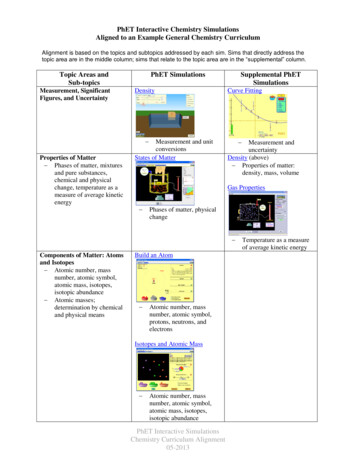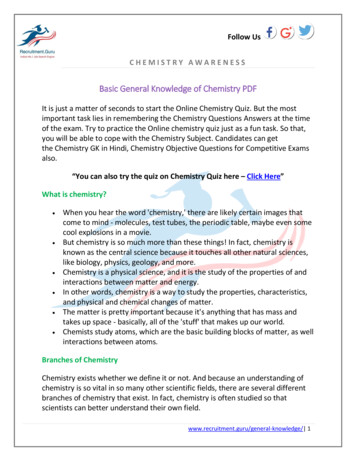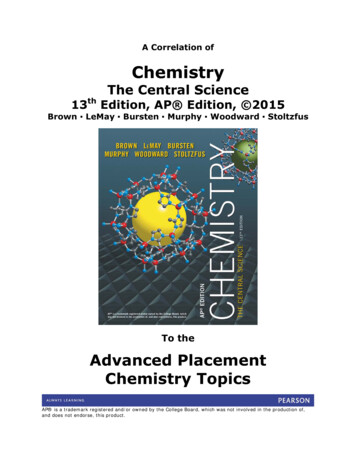
Transcription
PhET Interactive Chemistry SimulationsAligned to an Example General Chemistry CurriculumAlignment is based on the topics and subtopics addressed by each sim. Sims that directly address thetopic area are in the middle column; sims that relate to the topic area are in the “supplemental” column.Topic Areas andSub-topicsMeasurement, SignificantFigures, and UncertaintyPhET SimulationsDensity Properties of Matter Phases of matter, mixturesand pure substances,chemical and physicalchange, temperature as ameasure of average kineticenergyMeasurement and unitconversionsStates of MatterSupplemental PhETSimulationsCurve Fitting Measurement anduncertaintyDensity (above) Properties of matter:density, mass, volumeGas Properties Phases of matter, physicalchange Components of Matter: Atomsand Isotopes Atomic number, massnumber, atomic symbol,atomic mass, isotopes,isotopic abundance Atomic masses;determination by chemicaland physical meansBuild an Atom Atomic number, massnumber, atomic symbol,protons, neutrons, andelectronsIsotopes and Atomic Mass Atomic number, massnumber, atomic symbol,atomic mass, isotopes,isotopic abundancePhET Interactive SimulationsChemistry Curriculum Alignment05-2013Temperature as a measureof average kinetic energy
Development of the AtomicView of Matter / Evidence forthe Atomic Theory Dalton’s atomic theory,discovery of the electron(Millikan and Thompson),discovery of the atomicnucleus (Rutherford)Rutherford ScatteringAtomic Structure of Matter andQuantum Theory Electromagnetic spectrum,interference, blackbodyradiation, photoelectriceffect, Rydberg Equation,Bohr model, atomic linespectra, wave-particleduality, de Brogliewavelength, Heisenberg’suncertainty principle,Schrodinger equation,atomic orbitals, quantumnumbers and energy levelsBlackbody Spectrum Discovery of the atomicnucleus (Rutherford)Neon Lights and Other DischargeLampsElectromagnetic spectrum,blackbody radiationPhotoelectric EffectAtomic line spectra, atomicorbitals, quantum numbers andenergy levelsWave Interference Electromagnetic spectrum,photoelectric effectModels of the Hydrogen Atom Electromagnetic spectrum,interferenceQuantum Wave Interference Electromagnetic spectrum,Rydberg Equation, Bohrmodel, atomic line spectra,wave-particle duality,Schrodinger equation,atomic orbitals, quantumnumbers and energy levelsPhET Interactive SimulationsChemistry Curriculum Alignment05-2013 Electromagnetic spectrum,interference, wave-particleduality, de Brogliewavelength
Build an Atom (above) Periodic trends (atomicnumber, number ofelectrons)Electron Configuration andPeriodic Trends Pauli exclusion, Aufbauprinciple, and Hund’s rule;electron configuration;orbital diagram; shielding;periodic trends (atomic size,ionization energy, electronaffinity); periodic trends(electronegativity, metallicbehavior, ion size)Neon Lights and Other DischargeLamps (above) Ionization energyBalloons and Static Electricity Components of Matter:Elements and Compounds Periodic table, metals,nonmetals, metalloids,molecules from atoms,general bonding, ionic andcovalent bonding, formulas,molecular mass, molecularmodels, mixtures and puresubstancesBuild a Molecule Periodic table, moleculesfrom atoms, covalentbonding, formulas,molecular modelsElectrostatic attractions,effective nuclear charge,electron affinitySugar and Salt Solutions Ionic and covalent bonding,formulas, mixtures andpure substancesSugar and Salt Solutions (above) Binary ionic compounds,polyatomic ionsNomenclature Binary ionic compounds,binary covalent compounds,polyatomic ions, oxoanions,hydrates, acids and bases,organic moleculesSalts and Solubility PhET Interactive SimulationsChemistry Curriculum Alignment05-2013Binary ionic compounds,polyatomic ions
Chemical Bonding Lewis dot structures, octetrule; ionic bonding model,covalent bonding model;covalent bond order, bondlength, lone pairs;electronegativity and bondpolarity, partial ioniccharacter, metallic bonding(electron sea model) Binding forces (types;relationships to states,structure, properties;polarity andelectronegativity)Atomic InteractionsMolecular Geometry andPolarity, Molecular Structure,Molecular Models Lewis dot structures andgeometry, resonance, formalcharge, VSEPR, shape andmolecule polarity Geometry of molecules andions, orbital hybridization,dipole moments ofmolecules; relation ofproperties to structureMolecule Shapes Covalent bonding model,binding forcesMolecule Polarity (Tab 1) Electronegativity and bondpolarity, partial ioniccharacter, partial covalentcharacterBinding forces (polarityand electronegativity) Build a Molecule (above) (Tab 3) Geometry of moleculesVector Addition Geometry of molecules,VSEPRMolecule Polarity Bond dipoles andmolecular dipoles(polarity supplement)Shape and moleculepolarityDipole moments ofmolecules; relation ofproperties to structureBuild a Molecule (above) Geometry of smallorganic moleculesOrganic Compounds Nomenclature, structures,hydrocarbons, alkanes,functional groups,structural isomerism ofsimple organic moleculesPhET Interactive SimulationsChemistry Curriculum Alignment05-2013
Balancing Chemical EquationsChemical Equations andStoichiometry The mole and molar mass,amount-mass-numberconversions, masspercent, empiricalformula/combustionanalysis, balancing Balancing chemicalchemical equations,equations, mole ratios,limiting reactants,conservation of masstheoretical and actualpercent yields, aqueousReactants, Products andionic reactionsLeftovers Conservations of mass Chemical Reactions andSolutions Dissociation, strong andweak electrolytes,polyprotic acids,titrations, precipitationreactions, acid-basereactions, redox reactions,solution concentrationand units of molarityBalancing chemicalequations, limitingreactants, mole ratios,conservations of massConcentration Solution concentrationand units of molaritySugar and Salt Solutions Dissociation, strong andweak electrolytes,solution concentrationMolarity Solution concentrationand units of molarityAcid-Base Solutions Acid-base reactions,dissociation, strong andweak electrolytes,solution concentrationBeer’s Law Lab PhET Interactive SimulationsChemistry Curriculum Alignment05-2013Solution concentrationand units of molarity
Thermochemistry Energy, heat and work, 1stlaw of thermodynamics,state functions and pathfunctions, enthalpy,endothermic andexothermic processes,heat capacity,calorimetry,thermochemicalstoichiometry, Hess’ law,standard enthalpies ofreaction Endothermic andexothermic physicalprocesses, bonddissociation energyEnergy Forms and Changes Energy, heat, and work,endothermic andexothermic processes,heat capacityReactions & Rates Endothermic andexothermic chemicalprocessesMolecules and Light Bond dissociationenergy, endothermicchemical processes,chemical bondsEnergy Skate Park PhET Interactive SimulationsChemistry Curriculum Alignment05-2013Energy, 1st law ofthermodynamics,
Gases States of matter, gas laws,partial pressure, gasstoichiometry, kineticmolecular theory, RMSspeed, effusion anddiffusion, mean freepath/collision frequency,real gasesGas Properties Gas laws, partialpressure, kineticmolecular theory RMSspeed, mean freepath/collision frequencyBalloons and Buoyancy States of MatterStates of matter, gaslaws, partial pressure,gas stoichiometry,kinetic-molecular theoryof gases, RMS speed,effusion and diffusion,mean free path/collisionfrequency, real gasesMembrane Channels Real gases, states ofmatter Intermolecular Forces Dipole-dipoleinteractions, hydrogenbonding, dispersionforces, consequences forproperties of matter(vapor pressure andboiling points) Effusion and diffusionSugar and Salt Solutions (above) Hydrogen bonding,dipole-dipole interactionsStates of Matter (above) Hydrogen bonding,dispersion forces,consequences forproperties of matterCharges and Fields Dipole-dipoleinteractions, dispersionforces, electrostaticattractionsBalloons and Static Electricity(above)Electrostatic attractions,dispersion forcesPhET Interactive SimulationsChemistry Curriculum Alignment05-2013
Chemical Kinetics, Reactions,and Rates Reactions and rates, ratelaws, integrated rate laws,temperature andactivation energy,reaction mechanisms,catalysis Collision theory, reactionrates, factors influencingreaction rateReactions & Rates Reactions and rates,kinematics, temperatureand activation energy,collision theory, factorsinfluencing reaction ratesReversible Reactions Equilibrium Concept of dynamicequilibrium, reversibilityof reactions, equilibriumexpressions Quantitative treatment:equilibrium constants ofgas phase reactions,equilibrium constants forreactions in solution Le Chatelier's principle,reaction quotient (Q vs.K), effect of temperatureand pressure onequilibriumReaction rates,temperature andactivation energy, factorsinfluencing reaction ratesSalts and Solubility Concept of dynamicequilibrium, reversibilityof reactions Quantitative treatment,equilibrium constants forreactions in solution Le Chatelier's principleReactions & Rates (above) Concept of dynamicequilibrium: reversibilityof reactions Le Chatelier's principle,effect of temperature andpressure on equilibriumPhET Interactive SimulationsChemistry Curriculum Alignment05-2013pH Scale Concept of dynamicequilibrium, reversibilityof reactionsAcid-Base Solutions (above) Concept of dynamicequilibrium: reversibilityof reactions
Acids, Bases, and Acid-BaseEquilibria Acids and bases, protontransfer reactions,autoionization and the pHscale, weak acids andbases, equilibriumcalculations, molecularproperties and acidstrength, acid-baseproperties of salts Arrhenius acids andbases, hydrogen ions,hydroxide ions, BronstedLowry acids and bases,hydronium ions,concentration, acid-basereactions, buffering, LeChatelier’s principleAcid-Base Solutions Acids and bases, protontransfer reactions,autoionization and thepH scale, weak acids andbases, equilibriumcalculations, molecularproperties and acidstrength, acid-baseproperties of saltsArrhenius acids andbases, hydrogen ions,hydroxide ions,Bronsted-Lowry acidsand bases, hydroniumions, concentrationpH Scale Solubility EquilibriaLiquid state, solutions, ionicbonds, ions, complex ions,solubility, diffusion, osmosisAcids and bases, protontransfer reactions,autoionization and thepH scale, weak acids andbases, equilibriumcalculations, molecularproperties and acidstrength Arrhenius acids andbases, hydrogen ions,hydroxide ions,Bronsted-Lowry acidsand bases, hydroniumions, concentrationSalts and Solubility (above) Liquid state, solutions,ionic bonds, ions,complex ions, solubility,diffusionSugar and Salt Solutions (above)Solutions, ionic bonds, ions,complex ions, solubilityPhET Interactive SimulationsChemistry Curriculum Alignment05-2013Beer’s Law Lab (above) Solutions, solubilityMembrane Channels (above)Diffusion, osmosis
Buffers and Titrations Qualitative andquantitative aspects ofbuffers, capacity andrange, titrations, acid-baseindicatorsReversible Reactions (above) Concept of a"spontaneous" process,entropy, the 2nd law ofthermodynamics, entropyand probability, GibbsEnergy ("Gibbs FreeEnergy"), connection toequilibrium.Entropy and the Second Law ofThermodynamics Concept of a"spontaneous" process,entropy, the 2nd law ofthermodynamics, entropyand probability, GibbsEnergy ("Gibbs FreeEnergy"), connection toequilibrium.Oxidation-Reduction Reactionsand Electrochemistry Oxidation/reductionreactions, electrochemicalcells, standard cellpotentials, Gibbs energyand electrical work,batteries and corrosion,electrolysis Voltaic cell, oxidationreduction reactions,electrochemical reaction,current, voltage,electrodes, half-reactions,fuel cells, efficiencyPhET Interactive SimulationsChemistry Curriculum Alignment05-2013
Molecule Shapes (above) Geometric structures ofcoordination compoundsand optical isomersTransition Metals andCoordination Compounds Chemistry of thetransition metals,coordination compounds,geometric structures ofcoordination compoundsand optical isomers,crystal field theory,coordination compoundsin biology Solid state, alloys, metals,crystals, manipulation ofphysical structure toachieve specificproperties, mole conceptBeer’s Law Lab (above) Chemistry of thetransition metalsConductivity Solid state, metals,manipulation of physicalstructure to achievespecific propertiesSemiconductors Nuclear Chemistry Nuclear equations, halflives, radioactivity,isotopes, radioactivedecay series, band ofstability The atomic nucleus andradioactivity, kinetics ofradioactive decay Alpha particles, betaparticles, gamma rays,alpha decay, beta decay Nuclear fusion, nuclearfission, nuclear strongforce Chemical applications,biological effects ofradiationAlpha Decay Nuclear equations, halflives, radioactivity,isotopes, radioactivedecay seriesThe atomic nucleus andradioactivity, kinetics ofradioactive decayAlpha particles, alphadecay, nuclear strongforceBeta DecayPhET Interactive SimulationsChemistry Curriculum Alignment05-2013Solid state, metals,manipulation of physicalstructure to achievespecific properties
Nuclear equations, halflives, radioactivity,isotopes, radioactivedecay seriesThe atomic nucleus andradioactivity, kinetics ofradioactive decayBeta particles, betadecay, nuclear strongforceNuclear Fission Radioactivity, isotopesThe atomic nucleus andradioactivity, kinetics ofradioactive decayNuclear fission, nuclearstrong forceChemical applications,nuclear reactorRadioactive Dating Game Nuclear equations, halflives, radioactivity,isotopes, radioactivedecay seriesThe atomic nucleus andradioactivity, kinetics ofradioactive decayChemical applicationsPhET Interactive SimulationsChemistry Curriculum Alignment05-2013
Light and Matter Interactions Models of the Hydrogen Atom(above)and Spectroscopy Topic may be discussed Line emission spectrumthroughout the Electromagneticcurriculum.spectrumBeer’s Law Lab (above) Absorbance,transmittance, molarabsorptivity Visible spectrumBending Light Diffraction, refraction,reflectionColor VisionThe Greenhouse Effect ElectromagneticspectrumVisible spectrum Environmental chemistryRotational, vibrational,Microwavesand emissionspectroscopy, bondenergy, electromagneticspectrumMolecules and Light Environmental chemistryRotational, vibrational,and emissionspectroscopy, bondenergy, electromagneticspectrumPhET Interactive SimulationsChemistry Curriculum Alignment05-2013Polarity,intermolecular forces,rotationalspectroscopy,temperature
Binary ionic compounds, polyatomic ions Salts and Solubility Binary ionic compounds, polyatomic ions . PhET Interactive Simulations Chemistry Curriculum Alignment 05-2013 Chemical Bonding Lewis dot structures, octet rule; ionic bonding model, covalent bonding model;










